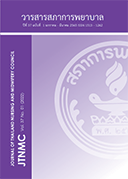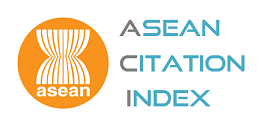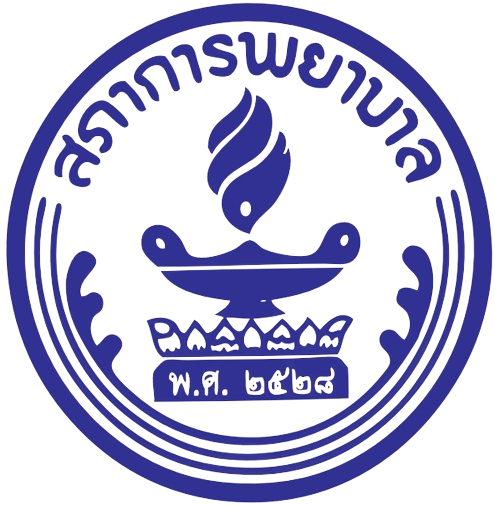การพยาบาลผู้ป่วยที่มีภาวะไตวายเฉียบพลันภายหลังผ่าตัดหัวใจในหอผู้ป่วยวิกฤต
คำสำคัญ:
การพยาบาล, ผู้ป่วยภาวะไตวายเฉียบพลัน, หลังผ่าตัดหัวใจ, หอผู้ป่วยวิกฤตบทคัดย่อ
ภาวะไตวายเฉียบพลัน (acute kidney injury: AKI) เป็นภาวะแทรกซ้อนที่พบได้บ่อยภายหลังผ่าตัดหัวใจ เกิดจากปัจจัยเสี่ยง 3 ระยะ ได้แก่ ระยะก่อนผ่าตัด ระยะผ่าตัด และระยะหลังผ่าตัด ส่งผลกระทบต่อไตทั้งทางตรงและทางอ้อม ทำให้การทำงานของไตลดลงอย่างเฉียบพลัน สูญเสียความสามารถในการควบคุมสารน้ำ เกลือแร่ เกิดการเปลี่ยนแปลงของสมดุลกรดด่างและเกิดภาวะไตวายเฉียบพลัน แม้ว่าปัจจัยเสี่ยงหลายปัจจัยในระยะก่อนผ่าตัดและระยะผ่าตัดเป็นปัจจัยเสี่ยงที่หลีกเลี่ยงไม่ได้ แต่ปัจจัยเสี่ยงระยะหลังผ่าตัดส่วนใหญ่เป็นปัจจัยที่สามารถจัดการเพื่อป้องกันและลดความรุนแรงของภาวะไตวายเฉียบพลันหลังผ่าตัดหัวใจได้ บทความนี้มีวัตถุประสงค์เพื่อทบทวนวรรณกรรมเกี่ยวกับพยาธิสรีรวิทยาของภาวะไตวายเฉียบพลันหลังผ่าตัดหัวใจ เกณฑ์การวินิจฉัยภาวะไตวายเฉียบพลัน การรักษาและการพยาบาลผู้ป่วยที่มีภาวะไตวายเฉียบพลันหลังผ่าตัดหัวใจ ซึ่งพยาบาลในหอผู้ป่วยวิกฤตมีบทบาทสำคัญในการประเมินภาวะเสี่ยงตั้งแต่ระยะก่อนผ่าตัด ระยะผ่าตัด ตลอดจนต้องมีทักษะความรู้ในการดูแลผู้ป่วยพร้อมทั้งเฝ้าระวังปัจจัยเสี่ยงระยะหลังผ่าตัด ได้แก่ภาวะปริมาตรเลือดส่งออกจากหัวใจต่อนาทีต่ำ (low cardiac output) ภาวะความดันโลหิตต่ำ (hypotension)การติดเชื้อในกระแสเลือด (sepsis) เฝ้าระวังยาที่ผลต่อไต (nephrotoxicagent) รวมทั้งสามารถให้การดูแลผู้ป่วยที่มีภาวะไตวายเฉียบพลันรุนแรงที่ต้องได้รับการบำบัดทดแทนไตเพื่อลดผลของภาวะไตวายเฉียบพลัน ลดระยะเวลารักษาในโรงพยาบาลและอัตราการเสียชีวิตเพื่อให้ผู้ป่วยฟื้นหายจากภาวะไตวายเฉียบพลันและป้องกันภาวะไตวายเรื้อรังในอนาคต
Downloads
References
Srisawat N, Tungsanga K. Acute kidney injury. Journal of The Department of Medical Services. 2017;42(6):64-8. (in Thai)
Silva TF, Cruz Silva KR, Nepomuceno CM, Corrêa CSM, Godoy JPM, dos Santos ATL, et al. Incidence of acute kidney injury post cardiac surgery: a comparison of the AKIN and KDIGO criteria. Braz J Anesthesiol.2021.doi:https://doi.org/10.1016/j. bjane.2021.02.016
Leballo G, Moutlana HJ, Muteba MK, Chakane PM. Factors associated with acute kidney injury and mortality during cardiac surgery. Cardiovasc J Afr. 2020;31(4):205-12.
Alshaikh HN, Katz NM, Gani F, Nagarajan N, Canner JK, Kacker S, et al. Financial impact of acute kidney injury after cardiac operations in the United States. Ann Thorac Surg. 2018;105(2):469-75.
Petäjä L, Vaara S, Liuhanen S, Suojaranta-Ylinen R, Mildh L, Nisula S, et al. Acute kidney injury after cardiac surgery by complete KDIGO criteria predicts increased mortality. J Cardiothorac Vasc Anesth. 2017;31(3):827-36.
ChewSTH,HwangNC.Acute kidney injury after cardiac surgery: A narrative review of the literature. J Cardiothorac Vasc Anesth. 2019;33(4):1122-38.
Vives M, Hernandez A, Parramon F, Estanyol N, Pardina B, Muñoz A, et al. Acute kidney injury after cardiac surgery: prevalence, impact and management challenges. Int J Nephrol Renovasc Dis. 2019;12:153-66.
Hoste EA, Kellum JA, Selby NM, Zarbock A, Palevsky PM, Bagshaw SM, et al. Global epidemiology and outcomes of acute kidney injury. Nat Rev Nephrol. 2018;14(10):607-25.
Zou H, Hong Q, Gaosi X. Early versus late initiation of renal replacement therapy impacts mortality in patients with acute kidney injury post cardiac surgery: a meta-analysis. Crit Care. 2017;21(1):1-10.
Chew STH, Ng RRG, Liu W, Chow KY, Ti LK. Acute kidney injury increases the risk of end-stage renal disease after cardiac surgery in an Asian population: aprospective cohort study.BMCNephrol. 2017;18(1):1-8.
WangY,BellomoR.Cardiacsurgery-associated acute kidney injury: risk factors, pathophysiology and treatment.NatRevNephrol.2017;13(11):697-711.
Ramos KA, Dias CB. Acute kidney injury after cardiac surgery in patients without chronic kidney disease.BrazJCardiovascSurg2018;33(5):454-61
Djordjević A, Šušak S, Velicki L, Antonič M. Acute kidney injury after open-heart surgery procedures. Acta Clin Croat. 2021;60(1.):120-6.
Ostermann M, Liu K, Kashani K. Fluid management in acute kidney injury.Chest.2019;156(3):594-603.
Dushimiyimana V. Knowledge of nurses in the early detection and management of acute kidney injury in a selected hospital in Rwanda [Dissertation]. Kigali: University of Rwanda; 2017.
Joannidis M, Druml W, Forni L, Groeneveld A, Honore P, Hoste E, et al. Prevention of acute kidney injury and protection of renal function in the intensive care unit:update2017.IntensiveCareMed.2017;43(6): 730-49.
Murphy F, Byrne G. The role of the nurse in the management of acute kidney injury.Br JNurs. 2010; 19(3):146-52.
Kidney Disease: Improving Global Outcomes (KDIGO)Acute Kidney Injury Work Group.KDIGO clinical practice guideline for acute kidney injury. Kidney int Suppl. 2012; 2: 1–138.
Gumbert SD, Kork F, Jackson ML, Vanga N, Ghebremichael SJ, Wang CY, et al. Perioperative acute kidney injury. Anesthesiology.2020;132(1): 180-204.
Jiwakanon S, Warodomwichit D, Supasyndh O, Chattranukalchai P, Pitprasert V, Nongnuch A, et al. Clinical practice recommendations for nutritional management in adult kidney patients 2018. The Thai Journal of Parenteral and Enteral Nutrition.
;28(2):18-67. (in Thai)
Chen X, Huang T, Cao X, Xu G. Comparative effcacy of drugs for preventing acute kidney injury after cardiac surgery: a network meta-analysis. Am J Cardiovasc Drugs. 2018;18(1):49-58.
AhmedAR,ObilanaA,LappinD.Renal replacement therapy in the critical care setting.Crit Care Res Pract. [internet]. 2019 [cited 2021 Mar 1]; 1-11. Available from: https://doi.org/10.1155/2019/6948710
MeloGAA,SilvaRA,GalindoNetoNM,LimaMAd, Machado MdFAS, Caetano JÁ. Knowledge and care practice of nurses of intensive care units regarding acute kidney injury.Texto Contexto Enferm.2020;29: e20190122. doi: 10.1590/1980-265X-TCE- 2019-0122.
Niyomwit K, Wannachot J. Nursing care for critically ill children with acute kidney injury using continuous venovenous hemofltration. Journal of Phrapokklao Nursing College. 2016; 27(2):149-59. (in Thai)
Bourbonnais FF, Slivar S, Malone-Tucker S. Caring for patients onCRRT--Key safety concernsidentifed by nurses. Can J Crit Care Nurs. 2020;31(2):13-9
Downloads
เผยแพร่แล้ว
How to Cite
ฉบับ
บท
License
Copyright (c) 2022 วารสารสภาการพยาบาล

This work is licensed under a Creative Commons Attribution-NonCommercial-NoDerivatives 4.0 International License.







